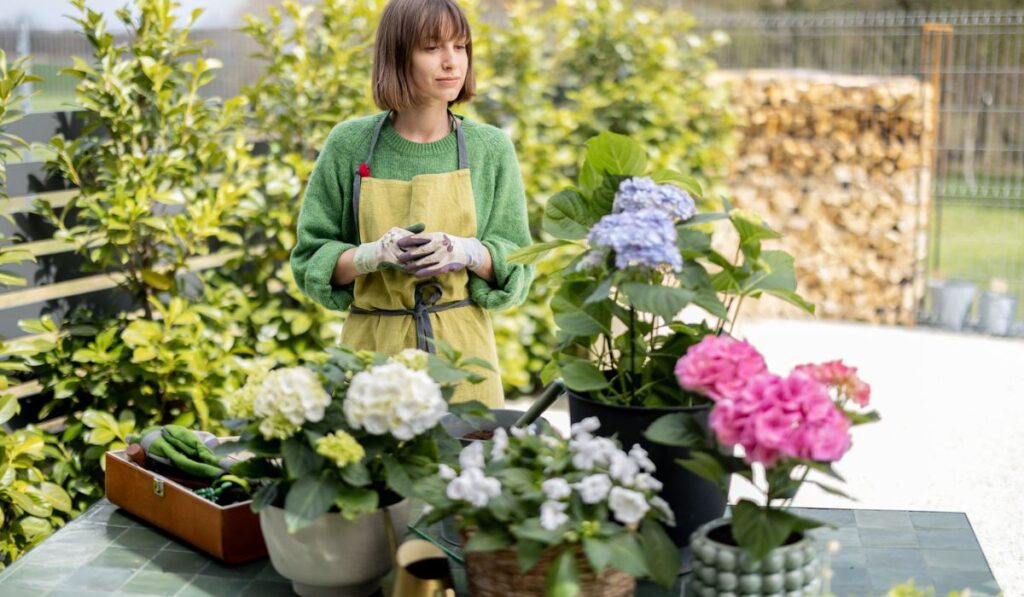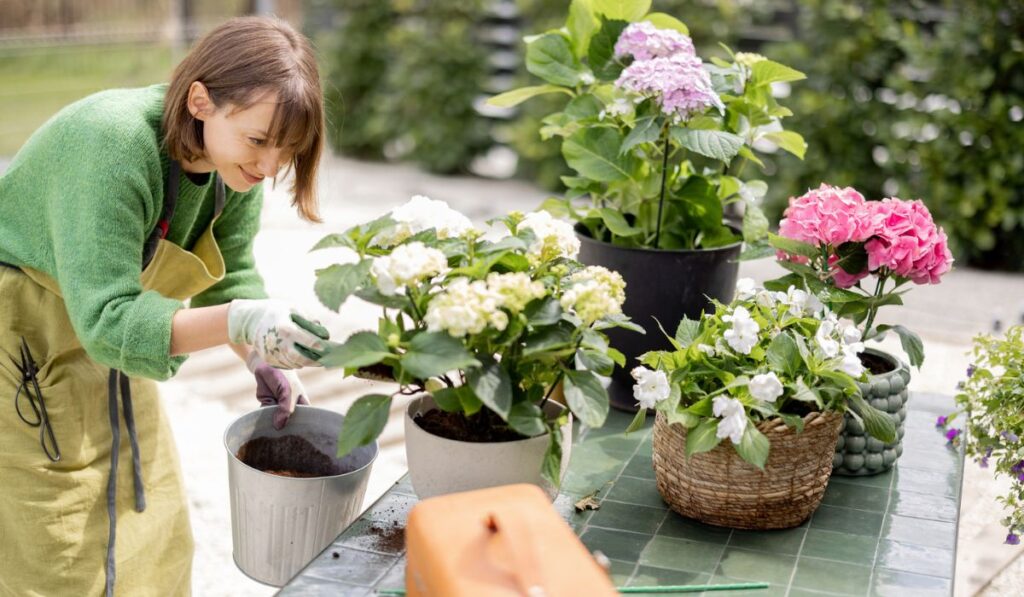Hydrangeas are wildly popular plants that often line fences or houses due to their large size and stunning flowers. They can bloom all summer long and, with proper care, can even provide some fall flowers. With a range of colors, it is no wonder they are seen in almost every garden.
Hydrangeas need the morning sun but coverage in the afternoon. Different varieties have different pruning and fertilization techniques that can be found on individual labels. When planting a hydrangea, the hole must be as deep as the root ball and 2-3 times wider. Regular soaking is recommended.
The most interesting concept of hydrangeas comes from their color, which can change depending on the pH level in your soil. Top this with their large and vibrant blooms and ease of care; hydrangeas are one of the most popular plants gardeners tend to have. Knowing the proper care for your hydrangea will provide a long life full of color that can be enjoyed over the years.
When to Plant Hydrangeas

Hydrangeas (on Amazon) should be planted in the cool seasons, with fall being the optimal choice and spring being a close second. The purpose is to ensure the shrub has plenty of time to get its root system established before the heat of summer and the cold of winter.
The best time of day to plant hydrangeas is in the early morning or late afternoon, in cooler temperatures, to avoid heat stress from the midday heat and direct sunlight.
Different Types of Hydrangeas
- Oakleaf: These thrive in warmer zones and are hardy hydrangeas that can withstand the high heat of summers.
- Bigleaf: The most common variety of hydrangea goes from dark blue to pink, depending on the soil pH level.
- Limelight: A summer-long bloom with large 12-inch flowers that are lime green but then fade to cream, pink, red, or burgundy as the season progresses. These are often chosen for their ability to provide beautiful hedges and foundations.
- French/Mophead: Softball-sized flowers that transition between colors as the plant ages. The color can shift between pink and blue depending on the soil’s pH level.
- Panicle: An easy, hardy hydrangea variety that can grow up to 15 feet tall.
- Smooth: Typically grows about 3-6 feet tall and tolerates full sun. They are drought tolerant and bloom white flowers that are not affected by the pH of the soil.
How to Plant Hydrangeas
Location
Hydrangeas love the warm morning sun and do well in garden beds next to homes or fences. However, they don’t tolerate the afternoon heat well and like a bit of cover once those midday rays come out. So the north or south side of your home is preferable, where the morning sun can shine, but the afternoon is shady.
Avoid planting them directly underneath trees as this will lead to competition with the tree for water and nutrients. Tree roots tend to sap all water from the nearby ground and often leave other plants in a drought.
Another thing to consider when looking for a place to plant the hydrangea is the wind. High winds will rip the foliage and tear off the large flowers, so some shelter from the wind is ideal.
Hydrangeas love soil that has a lot of organic material and good drainage. They don’t tolerate wet feet but do need to maintain constantly moist soil. If your soil is heavy or clay-like, try mixing in compost to improve soil quality and aeration.
Planting
To plant a hydrangea:
- Gently remove it from its container and inspect the root ball.
- Snip off any dead or rotting parts and tease the roots free so they aren’t so tightly knitted together.
- Dig a hole as deep as the root ball and about 2 to 3 times as wide. You want the base of the plant, where the stem meets the soil, to be level with the top of the hole.
- Set the hydrangea in the hole and fill it halfway with soil.
- Generously water it and allow the water to soak through before proceeding to fill in the remaining soil.
- Once entirely planted, go ahead and water it once more.
Maintaining Hydrangea Flowers

Watering
Growing hydrangea shrubs can be easy if you know their basic needs. For the first year or two after planting, ensure they get plenty of water as their root system is developing and getting established.
Soak them roughly three times a week instead of doing light sprinkles every so often, as this will encourage root growth. Keep in mind that Bigleaf and Smooth hydrangeas require more frequent watering and benefit significantly from consistent moisture.
You will know when you aren’t watering your hydrangea enough because the leaves will wilt, and the flowers won’t grow as vibrant or frequent. To ensure proper hydration, water in the morning so the hydrangea is prepared for the high heat of the afternoon.
Fertilizer
Fertilizing hydrangeas is a balancing act. If your soil is rich, you won’t need to fertilize them; if it is poor quality, you will need a steady supply of added nutrients. Be careful when fertilizing, as too much can hamper the growth of flowers and only create a mass of foliage.
To fertilize the hydrangea, looking at the label when purchasing your plant is best to ensure proper care for that specific variety. Typically, hydrangeas only need to be fertilized once or twice a year at the beginning and end of their growing season.
Winter Protection
Since hydrangeas are perennials, preparing them to last over the cold, snowy months is important. To do this, cover the plants at a depth of at least 18 inches in the fall with mulch, leaves, pine needles, and straw.
If possible, cover the entire plant with snow fencing or chicken wire and loosely fill it with leaves. However, don’t use maple leaves as they will suffocate the plant because they mat when wet.
Pruning
The difficulty with pruning hydrangeas comes from the fact that each variety has a different requirement. Therefore, you need to know which type of hydrangea you have before pruning, or you risk damaging the plant or cutting off flower buds.
Figuring out how to prune the plant can be found on the label that came with the specific plant upon purchase. However, typically, they are pruned in summer after they have flowered. You will want to prune one or two of the oldest stems down to the base to encourage branching and shrub fullness.
While some people like to prune hydrangeas, they don’t need any pruning if they are given plenty of room to grow. Instead, remove any dead wood and let the plant grow to its fullest potential.
Tips and Tricks
- Hydrangeas can grow between 3 to 10 feet tall and require enough spacing to reach maturity, so keep that in mind when selecting a planting site.
- Add organic material like mulch underneath the plant to keep the soil moist and cool while delivering nutrients over time.
- After planting in the fall, adding a 2-inch thick layer of mulch can help insulate the roots for winter.
- Changing the color of a hydrangea takes time and shouldn’t be done until the plant is at least two years old. To do so, you simply correct the soil pH level to the desired color. For example, a pH level of 5.5 or less gives blue flowers, and 6.0 or higher gives pink.
- Deadheading your hydrangea can keep the plant blooming into fall, and you don’t have to wait until the flower begins to wilt. Hydrangeas make great bouquet flowers for this reason.
